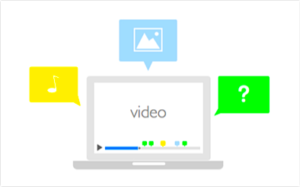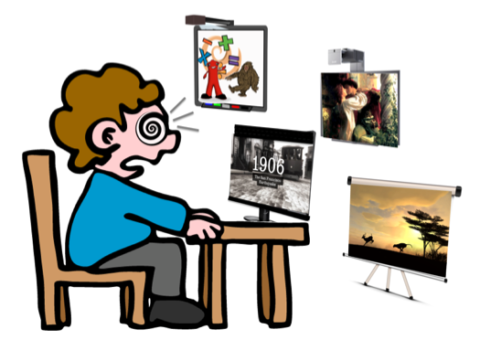If, When and How to Use Video in the Classroom
A MiddleWeb Blog
I am amazed and at times alarmed by how often some educators use video clips in the classroom.
I remember picking up my son from school one day last year. In our conversation on the way home, he told me that he had watched an ‘awesome’ video clip in 4 out of 5 of his classes that day.
Too Many Movie Clips?
I found myself interested – and a bit concerned. So in my visits to various schools and classrooms over the past 12 months, I have kept an informal tally. Here are the results:
Between 60 and 70 percent of the teachers I visited reported using video regularly (at least once a week) during class time. Of those same teachers, 35 percent reported using video often (three to five times a week) during class.
Obviously, these numbers aren’t based on solid research, nor do they tell us what the students watched. And they may not represent what goes on in other parts of the country. Still, I can’t help but wonder about the ‘video-fication’ of our students. Is the learning process being hindered by an excessive – and oftentimes ineffective – use of video?
Effective vs. Ineffective Use of Video
Last year, a piece from the New York Times reported that children born to low-income parents already spend at least 40 percent of their early morning hours in front of a screen—more than twice the time spent by middle-class children.
Some alarming results for these ‘screen-kids’ include less social interaction with family members, less robust vocabularies, ‘out-of-sync’ behavior with their classmates, and lower overall academic performance (Pinker, 2015). It seems unlikely, therefore, that more screen time at school would be a good idea.
The surprising truth is that incorporating video clips and other forms of multimedia into instructional activities actually does work – if used prudently. Teachers should start by asking themselves…how will using this video clip help my students meet their learning goals?
Loading up something on YouTube to get a quick laugh out of students, or to fill up some extra class time that we failed to plan for, or as a reward for ‘good behavior’ is unlikely to help our students gain much academically.
My own new-teacher confession
I admit that, as a new teacher, I fell prey to several of these blunders – that is until a concerned parent showed up at school the day after I had shown about 15 minutes of Napoleon Dynamite during class. I had intended to use about 3 minutes of it as an example of dramatic irony, but I ended up showing quite a bit more because…well…it was near the end of class and the students were loving it.

At first I was pretty mad. But it didn’t take me long to come to my senses and realize that what I had done was not an effective use of instructional time. Since that day, I have worked to better understand how and when video clips actually should be used in the classroom. Here are few examples of what works.
- To build background knowledge and/or to introduce new content.
- To illustrate a concept in a realistic way (e.g. showing an animation of meiosis).
- As a mnemonic device (e.g. helping students learn/remember the states/capitals or the parts of the cell).
- To reduce the cognitive load on students (e.g. using videos with subtitles to assist English Language Learners).
- As an advance organizer to a written text (e.g. showing a video about Mars before asking students to read an article on the same topic).
- To allow students to view the lecture portion of class at home (e.g. creating and posting a simple video on plate tectonics so that more time can be spent in class on a hands-on activity).
- To provide students help with their homework (e.g. making a tutorial that shows students how to work math problems).
- Allowing students to demonstrate mastery of content (e.g. asking students to use their phones to create short, original ‘one-take’ videos that explain vocabulary terms or concepts to others).
Using Video to Augment Learning: Tips & Tools
As a stand-alone activity, watching a video is a very passive and sedentary activity (Fields, 2016). I‘m fairly certain that’s why the babysitter that my siblings and I had growing up would use it as a form of “crowd control.” The moment my parents left the house, she would pop in one Disney movie after another. For hours, all of us would sit calmly, in our own little television-induced kiddy coma.

Fortunately, a variety of tools exist to help transform video-watching into a more participatory learning experience.
► Sites like EDuzzle and Vizia provide teachers simple, useful ways to enhance video clips on YouTube and other sites with questions, polls, writing prompts, and other interactive elements. Doing so requires students to view a segment, then pause, reflect, and answer questions before continuing on.
► Vialogues is another unique video tool. It’s designed to foster collaborative conversation about video clips. The site provides students a space to comment and converse about a video clip. All interactions are time-stamped and printable by the teacher. Click here to see an example.
► When it comes to using YouTube videos, there are a few tricks that every teacher should know. For example, teachers can specify a starting point for a YouTube video by clicking on the little ‘share’ icon that is below the ‘subscribe’ button and a little section will expand below with a checkbox called ‘Start At.’ Here teachers can decide at what point they want the video to start for their students.

► Turning on or creating your own video captions is another simple way to improve students’ learning experience. Using speech recognition technology, YouTube makes it possible to automatically create captions for videos you want to use in class. Captions allow information to be presented verbally and visually and can help boost student vocabulary, comprehension, and reading motivation (Hsu, et al., 2013).
From Ineffective to Effective Use of Video Clips
I would wager that the majority of teachers will use video at some point this year during their instruction. The real trick for each of us is to work strategically to ensure that we are using it in a way that improves student learning. But with some added attention, we can turn this potentially passive form of media into an instructional tool that students will engage with.
As an educator, it already seems that I never have enough instructional time with my students. As a parent, I worry that my kids are already spending too much time in front of a screen. Therefore, my plea to teachers is simple – use video effectively and efficiently in your classroom – or please don’t use it all.
Resources
• Hsu, C. K., Hwang, G. J., Chang, Y. T., & Chang, C. K. (2013). Effects of Video Caption Modes on English Listening Comprehension and Vocabulary Acquisition Using Handheld Devices. Educational Technology & Society, 16(1), 403-414.
• Kuhn, M., Hubbell, E. R., & Pitler, H. (2012). Using Technology with Classroom Instruction That Works ASCD.
• Pinker, S. (2015, January 30) Can students have too much tech? The New York Times, p. A2.
• Fields, D. (2016, January). Does TV Rot Your Brain? Scientific American.




































Did you ever consider that your use of the film Napoleon Dynamite was also a copyright violation?
Fair use laws allow some leeway when used for educational purposes.